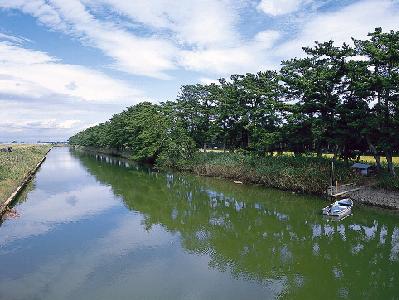貞山運河 Teizan-unga Teizan Canal
|
Teizan Canal, 46.6 km in total length, is Japan’s longest canal built along Sendai Bay, connecting the mouth of the Old Kitakami River and the mouth of the Abukuma River. The first section of the canal, which connected Matsushima Bay and the Abukuma River, was constructed in 1597 by the order of Date Masamune. After his death, the extension works were continued. The canal was named after Masamune’s Buddhist name.
Until the end of the 19th century, boats and ships were the main means of transportation in Japan. After the Meiji restoration (1868), Home Minister, Okubo Toshimichi, asked the governors of the 6 prefectures in the Tohoku region about what they most needed. As a result, he concluded that construction of the canal to connect the Kitakami River, the main artery of the region, and the Abukuma River was indispensable for transporting rice. The construction was completed in 1884.
Today, it is used as an agricultural waterway and functions as a part of fishing ports. In the area along the canal from the Nanakita River to the Natori River spreads a fine seaside park, where a beautiful pine grove continues and a cycling road is equipped.
Until the end of the 19th century, boats and ships were the main means of transportation in Japan. After the Meiji restoration (1868), Home Minister, Okubo Toshimichi, asked the governors of the 6 prefectures in the Tohoku region about what they most needed. As a result, he concluded that construction of the canal to connect the Kitakami River, the main artery of the region, and the Abukuma River was indispensable for transporting rice. The construction was completed in 1884.
Today, it is used as an agricultural waterway and functions as a part of fishing ports. In the area along the canal from the Nanakita River to the Natori River spreads a fine seaside park, where a beautiful pine grove continues and a cycling road is equipped.
- address
- Miyagino-ku, Sendai, Miyagi Prefecture 983-0000
- name
- Teizan Canal













